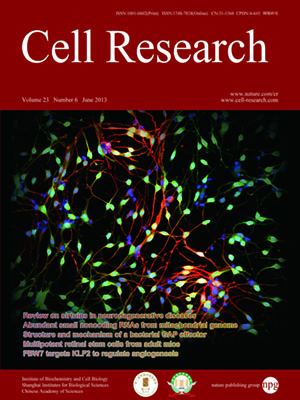
Volume 23, No 6, Jun 2013
ISSN: 1001-0602
EISSN: 1748-7838 2018
impact factor 17.848*
(Clarivate Analytics, 2019)
Volume 23 Issue 6, June 2013: 820-834
ORIGINAL ARTICLES
Hypertensive stretch regulates endothelial exocytosis of Weibel-Palade bodies through VEGF receptor 2 signaling pathways
Yan Xiong1, Zhenqian Hu1, Xiaofan Han1, Beibei Jiang1, Rongli Zhang2, Xiaoyu Zhang1, Yao Lu1, Chenyang Geng1, Wei Li3, Yulong He4, Yingqing Huo1, Masabumi Shibuya5 and Jincai Luo1
1Laboratory of Vascular Biology, Institute of Molecular Medicine, Peking University, Beijing 100871, China
2Non-human Primate Research Center, Institute of Molecular Medicine, Peking University, Beijing 100871, China
3People's Hospital, Peking University, Beijing 100871, China
4Laboratory of Vascular and Cancer Biology, Cyrus Tang Hematology Center, Soochow University, Suzhou, Jiangsu 215325, China
5Institute of Physiology and Medicine, Jobu University, Takasaki, Japan
Correspondence: Jincai Luo, Fax: +86-10-6275-0922 (jincailuo@pku.edu.cn)
Regulated endothelial exocytosis of Weibel-Palade bodies (WPBs), the first stage in leukocyte trafficking, plays a pivotal role in inflammation and injury. Acute mechanical stretch has been closely associated with vascular inflammation, although the precise mechanism is unknown. Here, we show that hypertensive stretch regulates the exocytosis of WPBs of endothelial cells (ECs) through VEGF receptor 2 (VEGFR2) signaling pathways. Stretch triggers a rapid release (within minutes) of von Willebrand factor and interleukin-8 from WPBs in cultured human ECs, promoting the interaction between leukocytes and ECs through the translocation of P-selectin to the cell membrane. We further show that hypertensive stretch significantly induces P-selectin translocation of intact ECs and enhances leukocyte adhesion both ex vivo and in vivo. Stretch-induced endothelial exocytosis is mediated via a VEGFR2/PLCγ1/calcium pathway. Interestingly, stretch also induces a negative feedback via a VEGFR2/Akt/nitric oxide pathway. Such dual effects are confirmed using pharmacological and genetic approaches in carotid artery segments, as well as in acute hypertensive mouse models. These studies reveal mechanical stretch as a potent agonist for endothelial exocytosis, which is modulated by VEGFR2 signaling. Thus, VEGFR2 signaling pathways may represent novel therapeutic targets in limiting hypertensive stretch-related inflammation.
10.1038/cr.2013.56
FULL TEXT | PDF
Browse 2439


